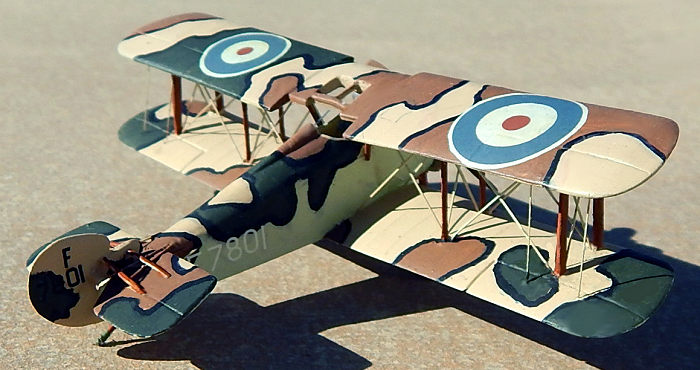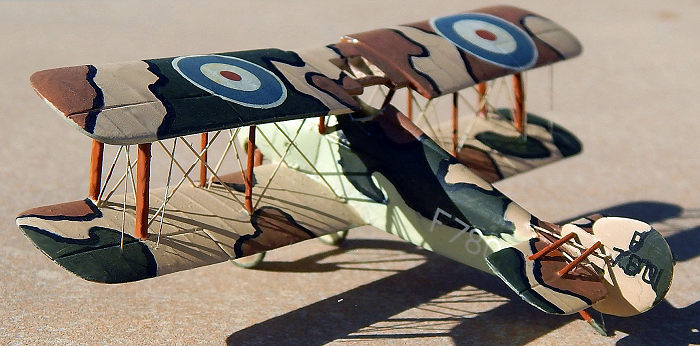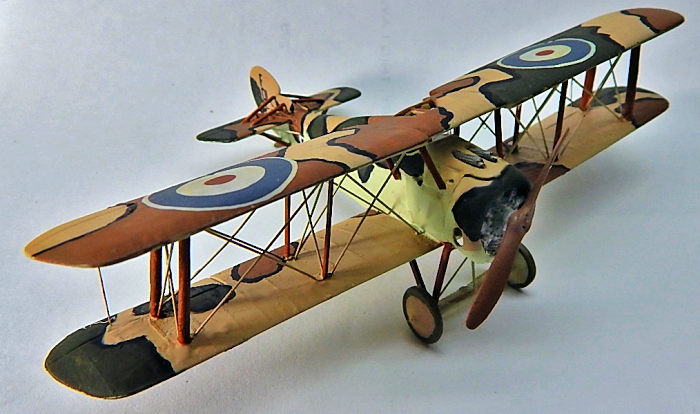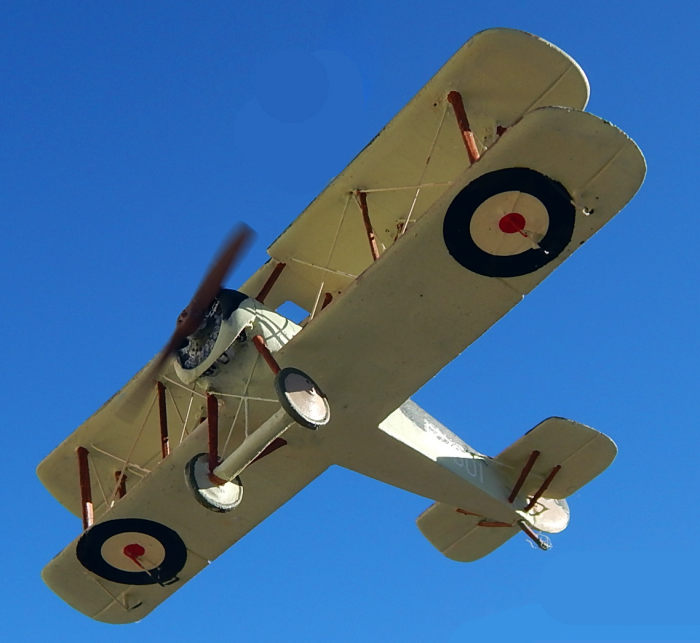
Pegasus 1/72 Sopwith Salamander
| KIT #: | 1007 |
| PRICE: | $ |
| DECALS: | One option |
| REVIEWER: | Carmel J. Attard |
| NOTES: | Short run with white metal propeller and engine cowling. |

| HISTORY |
 The
Salamander was an early biplane that was used for camouflage trials by
the Ministry of Munitions in 1918. Colour notes and reference are based
on documented Technical Department guidelines CIM 733 of 3rd Sept 1918
by Brigadier General J.G. Wier, controller Technical Department aircraft
production.
The
Salamander was an early biplane that was used for camouflage trials by
the Ministry of Munitions in 1918. Colour notes and reference are based
on documented Technical Department guidelines CIM 733 of 3rd Sept 1918
by Brigadier General J.G. Wier, controller Technical Department aircraft
production.
Camouflage on upper surfaces consisted essentially of disruptive scheme of dark purple earth, dark green, the border of all colors were painted over with non-linear black line which varied from 2” to 4” in width. On first prototype all markings except those on top wing removed with roundels of different diameter and non standard colors. Later early test Salamanders carried markings close to standard ones. Other areas were painted light green gray. The basis of the horizontal scheme was light earth which met the vertical components of the fuselage at the edge of the Turtle-Deck and along either side of the machine gun fairing.
 The
aircraft model represents one of six prototypes. The design of the
Salamander was generally the same as that of the 7F1 single rotary the
same big two-row rotary in a cowling cut away underneath to improve
cooling. Two 0.303” Vickers machine guns, each with 1,000 rounds of
ammunition were synchronized to fire between propeller blades. Pilot’s
position and fuel tanks were encased in armour plating adding 650 lbs to
the aircraft gross weight.
The
aircraft model represents one of six prototypes. The design of the
Salamander was generally the same as that of the 7F1 single rotary the
same big two-row rotary in a cowling cut away underneath to improve
cooling. Two 0.303” Vickers machine guns, each with 1,000 rounds of
ammunition were synchronized to fire between propeller blades. Pilot’s
position and fuel tanks were encased in armour plating adding 650 lbs to
the aircraft gross weight.
Plans were made for large scale production of the Salamander with 560 ordered from Sopwith and 600 more from other manufacturers. However all outstanding contracts were cancelled after the Armistice and only 102 Sopwith built machines had been completed. 37 of these on RAF charge in October 1918 and only 2 had arrived in France. Salamander F7801 represents one of 6 prototypes used for experimental camouflage.
| THE KIT |
 The kit is
injected in medium gray styrene and with surface detail reasonably good as also
are the flying surfaces with ribs being clearly marked. Metal parts include the
twin Vickers machine guns that fit on top decking of fuselage. Cylinder detail
on rotary engine clearly molded but is largely hidden inside a nice metal
cowling. I replaced the struts with metal ones in order to make the wing
assembly more rigid for the nylon rigging. These conformed in shape and size to
struts shown in drawing provided on the instructions. The tiny biplane is
infested with rigging and there was quite a bit of work drilling respective
holes to pass the line.
The kit is
injected in medium gray styrene and with surface detail reasonably good as also
are the flying surfaces with ribs being clearly marked. Metal parts include the
twin Vickers machine guns that fit on top decking of fuselage. Cylinder detail
on rotary engine clearly molded but is largely hidden inside a nice metal
cowling. I replaced the struts with metal ones in order to make the wing
assembly more rigid for the nylon rigging. These conformed in shape and size to
struts shown in drawing provided on the instructions. The tiny biplane is
infested with rigging and there was quite a bit of work drilling respective
holes to pass the line.
| CONSTRUCTION |
 Injected
parts were separated from the thick sprue tree and all flush which was of
excessive nature carefully trimmed off. Interior painted linen and added
detail consisting of seat complete with straps, control stick and rudder
pedals. Space inside was limited and interior was hardly visible after crew
figure was added. Two top decking space accommodated the twin Vickers
machine guns.
Injected
parts were separated from the thick sprue tree and all flush which was of
excessive nature carefully trimmed off. Interior painted linen and added
detail consisting of seat complete with straps, control stick and rudder
pedals. Space inside was limited and interior was hardly visible after crew
figure was added. Two top decking space accommodated the twin Vickers
machine guns.
The tail fin and horizontal stabilizers came as separate parts which were then joined to the fuselage. Next attached the lower main planes making sure they were perfectly perpendicular with the fuselage axis. The trimmed rotary engine painted and was attached to the firewall. Following that added the metal cowling. The propeller was left as a last item to add to the kit. Struts, interplane and undercarriage legs and spreader bar were added in place. Finally added the main wheels and tailskid. Rigging was added out of fishing line which was passed through fine pre drilled holes and then carefully secured with tiny drop of super glue.
| COLORS & MARKINGS |
I went after one of the six prototypes which were finished in light green grey undersides and the top surfaces as described earlier. A crew figure occupied the cockpit seat.
| CONCLUSIONS |
This was a time consuming kit build mostly due to its small size. Still it added an interesting history of the early days when new camouflage colors started to appear on combat aircraft. Thanks to Scott for making the kit available.
Carmel J. Attard
22 January 2018 Copyright ModelingMadness.com
If you would like your product reviewed fairly and fairly quickly, please contact the editor or see other details in the Note to Contributors.
Back to the Main Page Back to the Review Index Page Back to the Previews Index Page